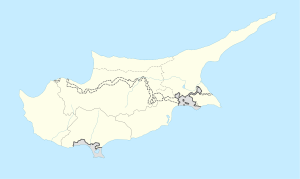Lefka
|
Lefka |
|
|---|---|

Orange monument in Lefka town centre, representing its rich orange groves
|
|
| Location in Cyprus | |
| Coordinates: 35°6′48″N 32°51′4″E / 35.11333°N 32.85111°ECoordinates: 35°6′48″N 32°51′4″E / 35.11333°N 32.85111°E | |
| Country |
|
| • District | Nicosia District |
| Country (controlled by) |
|
| • District | Lefke District |
| Government | |
| • Mayor | Aziz Kaya (CTP) |
| Population (2011) | |
| • Total | 3,009 |
| • Municipality | 11,091 |
| Time zone | FET (UTC+3) |
| Website | www |
Lefka (Greek: Λεύκα; Turkish: Lefke) is a town in Cyprus, overlooking Morphou Bay. De facto, it is under the control of Northern Cyprus. In 2011, the town-proper had 3,009 inhabitants. It is the capital of the Lefke District of Northern Cyprus, having been a sub-district centre in the Güzelyurt District until the establishment of the district in 2016.
Lefka is known for its citrus fruits and mines. It is the site of the European University of Lefke.
During the Venetian period in Cyprus, Lefka was dominated by Catholics of Italian descent. Turks migrated to Lefka during Ottoman rule.
Asil Nadir and Nil Burak were born in Lefka. The city houses the tomb of Nazim al-Haqqani, spiritual head of the Haqqani branch of the Naqshbandi Sufi order, died on 7 May 2014.
The first settlement in the Lefka area dates from the Neolithic period. According to one hypothesis, the town was founded in the 3rd century BC by Lefkos, the son of the Ptolemy king of Egypt, who is also said to have founded Nicosia (known as Lefkosia), and named after him. Another hypothesis states that a sick Christian girl named "Lefka", meaning poplar in Greek, came to the town to be healed by the clean air from the mountains. According to the legend, she lived in Lefka for a long time and died in the town, and the town was named after her to honor her memory.
...
Wikipedia

